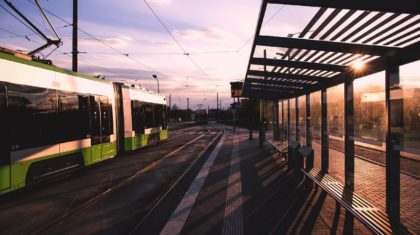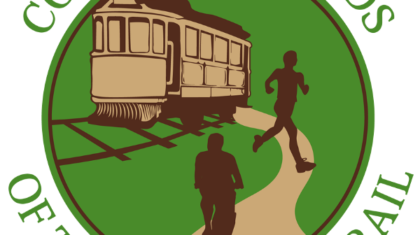
Maybe you’d like to take the bus to work, but the walk to the bus stop is too long. Wouldn’t it be great if there were a way to get to the bus stop faster than walking, but without having to deal with the hassles of park-and-ride? Behold! — the humble bicycle. The bicycle could be the perfect combination with transit: faster than biking on its own, yet more flexible than transit alone — and, as a package, supporting healthier lifestyles and economies.
Making it easier for people to combine bicycling and transit can improve access to jobs, contribute to healthier lifestyles, reduce personal and household transportation costs, and increase transportation choice.
So why don’t more people bike to and from bus stops and rail stations? And how can we encourage combining bikes and transit to help solve transit’s first/last mile problem, bicycling’s limited range, and leverage the health and economic benefits associated with fewer single occupant vehicle trips? Those are a few of the questions the Alta team was charged with answering during our recent project with the Atlanta Regional Commission (ARC).
ARC’s award-winning regional bicycle and pedestrian plan, Walk.Bike.Thrive!, outlines a vision for active transportation in the Atlanta region, including the role walking and bicycling plays in supporting transit, and vice-versa.

While working on Walk.Bike.Thrive!, we discovered a big opportunity: A third of the Atlanta region’s population lives within a 5-minute bike ride of a transit stop, while nearly two-thirds of the population works within a 5-minute bike ride of a transit stop.

Very few people are biking to transit, however, due to multiple barriers. The obvious challenges are a lack of low-stress bicycling facilities along the corridors that connect to transit, and a lack of adequate bike parking at transit stops.
But there are also psychological barriers:
-
Mode switch logistics
In a similar way that having to make a transfer may deter people from choosing transit for a given trip, having to switch from bicycling to a bus or train partway through a trip — including the mechanics associated with having to lock up one’s bike and/or bring it with them on a transit vehicle — are likely to be unfamiliar and may feel overly complex. -
Annoyance thresholds
In addition to traffic stress tolerance, people also have a threshold for the cumulative amount of discomfort and inconvenience they encounter when attempting to combine a bike trip with a transit trip. This includes seemingly minor details such as a lack of shade trees on a hot summer day, short sections of a route where pavement quality is poor, vehicles parked in bike lanes, a lack of curb ramps leading up to a bus stop or rail station, or bike parking placement that makes locking up one’s bike cumbersome. -
Travel time budgets
Depending on the trip distance, trip type, and travel time relative to driving, combining a bike trip with a transit trip may exceed the total amount of time people are willing to spend traveling to arrive at a given destination.
Moreover, it’s unlikely that many people would consider combining a bike trip with a transit trip the “ideal” way to get anywhere. People that are willing to consider riding a bike to the bus or a train likely fall into three categories:
1. People who would ideally prefer to make a short walking trip to transit, but their origin/destination is too far from the stop for this to be practical. A significant portion of these potential users are likely “Interested but Concerned” about biking and require a low-stress bikeway to the transit stop (e.g. conventional bike lanes on a busy street).
2. People who would ideally prefer to bike for the full duration of their trip, but their trip is too long, too hilly, or the weather isn’t conducive to bicycling on that day. Many of these potential users may be enthusiastic and confident or interested but concerned bicyclists who would not consider leaving their bike locked at a station all day unless long-term bike parking offers them a secure option.
3. People who would ideally prefer to drive, but rely on transit to access the places they need to go on a daily basis. Neither transit nor bicycling may be this group’s first choice, but they may ride a bike to a transit stop because walking distances are unreasonably long, because they are too young to drive, or because car ownership is not economically viable or efficient for them. The focus for these users should be on providing safe access with minimal delay.

Making bicycling to transit an attractive alternative to driving requires overcoming a significant set of physical and psychological barriers, and requires facilities to be held to a higher standard than is currently typical in the US.
This means focusing on providing a world-class user experience, with direct, low-stress bikeways that minimize delay while meeting the needs of people of all ages and abilities. It also means providing convenient, secure bike parking at high-ridership bus stops, park and ride lots, and rail stations. (And yes, a lot of it also has to do with land use patterns/policy, but that’s a whole ‘nother blog post!)
Here are some of the solutions Alta documented for the Atlanta Regional Commission:
1. Mitigate bike-bus conflicts with raised/floating boarding islands

2. Make park & ride lots bike friendly


3. Retrofit suburban roadway network design with trails and low-stress on-street bikeways

4. Install “Commercial Greenways” along narrow, pedestrian-friendly streets

5. Provide all ages and abilities crossings of major arterials

6. Reduce stress for people bicycling at freeway on- and off-ramps

7. Always provide free bike parking

8. Provide Secure Parking Areas (Bike SPAs) in high-demand areas

9. Implement Bike Valet at rail stations and bus transfer centers

10. Use this checklist to evaluate bus stops, rail stations, and park and ride lots during planning processes:

For more information, see the Atlanta Regional Commission’s Walk.Bike.Thrive! page here.
Direct download link for Bike to Ride full report:
https://atlantaregional.org/wp-content/uploads/arc-biketoride-webview.pdf
Contact info:
Byron Rushing, Bicycle and Pedestrian Program Manager
Atlanta Regional Commission
[email protected]
Collin Chesston, Senior Planner
Alta Planning + Design
[email protected]


